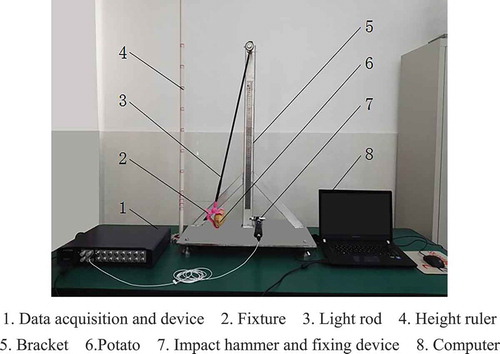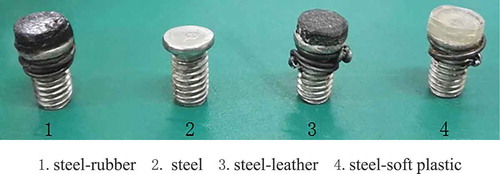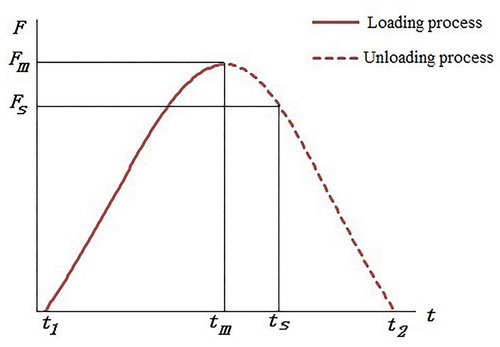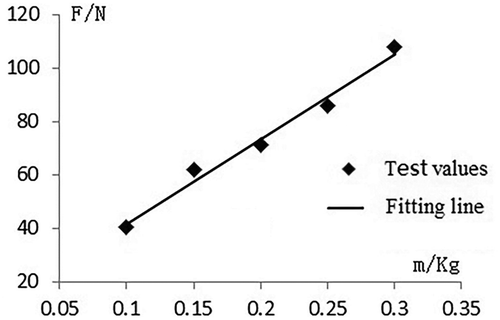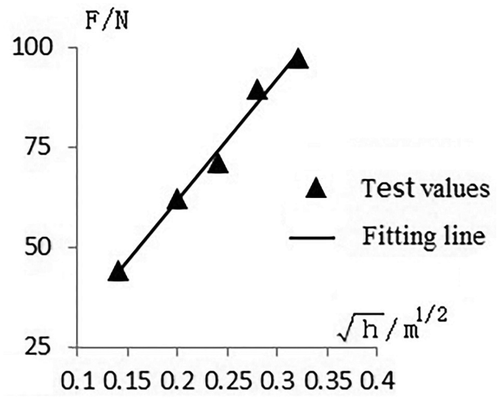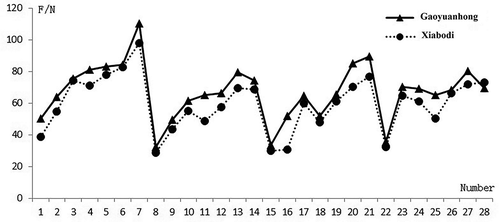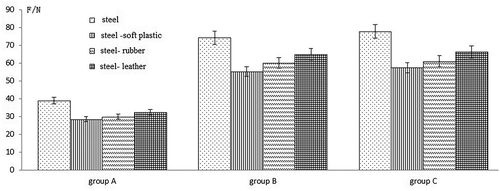 ?Mathematical formulae have been encoded as MathML and are displayed in this HTML version using MathJax in order to improve their display. Uncheck the box to turn MathJax off. This feature requires Javascript. Click on a formula to zoom.
?Mathematical formulae have been encoded as MathML and are displayed in this HTML version using MathJax in order to improve their display. Uncheck the box to turn MathJax off. This feature requires Javascript. Click on a formula to zoom.ABSTRACT
To analyze the influencing factors of impact force on potatoes, a mathematical model between the impact peak force, the potato mass
and the drop height
was established as
. A single-factor impact test was carried out, and the models for
,
and
were presented as
and
. Taking the combination form
of
and
as the test factor, the
of two potato varieties, namely, Xiabodi and Gaoyuanhong, were tested under the impact materials of steel, steel-soft plastic, steel-rubber and steel-leather. The relationships between
and
were all
under the four types of impact materials by the regression analysis of the test results. The range of
was from 980.9 to 1395.7. The effect of potato variety on
was analyzed. The results showed that under the same conditions, the
of Xiabodi was 8.03 N smaller than that of Gaoyuanhong on average, which indicated that Xiabodi had a better tolerance to impact force. The effect of impact material on
was analyzed. The results showed that
with steel, steel-leather, steel-rubber and steel-soft plastic decreased in turn, and the average difference between the maximum and minimum value of
was 16.6 N.
Introduction
Impact damage to potatoes is a common phenomenon during harvesting and post-harvesting operations.[Citation1–Citation3] It has been reported that 70% of the damage to potatoes is caused by harvesting, and impact and pressure are the main causes.[Citation4] Mechanical damage and collision abrasion seriously affect potato yield and cause a dual decline of potato appearance and quality that affect the development of the entire potato industry.[Citation5–Citation7] To analyze the factors that affect potato damage and reduce the damage rate, many scholars have performed many studies. In the field of experimental research, some researchers have used pendulum devices to study potato impact problems. Xie[Citation1] established a potato impact damage depth model using a single pendulum impact device and found the order of influencing factors that affect the impact damage depth through orthogonal experiments. Some researchers used a pendulum impact device to study the potato impact response with different tuber temperatures, initial heights, and impact materials and described the equation of the shape and volume of the bruise spots.[Citation8–Citation10] Some researchers used acoustic technique and a pendulum impact testing system with film sensors or an accelerometer to evaluate the firmness and stiffness of fruits and vegetables.[Citation11–Citation13] Other researchers used free-fall devices to study the speed, force, respiration and bruise volume of potatoes after impacting with different objects under different conditions.[Citation14–Citation17] Some researchers used instrumented potatoes to record the extent of impact and predict tissue discoloration to find the relationship between potato damage and harvest parameters.[Citation18,Citation19] In terms of simulations, the dynamic responses of potato collision at different heights were studied using the finite element method. The impacting structural stresses, peak force time, maximum impact force, and maximum deformation were obtained.[Citation3,Citation20,Citation21]
Based on these studies, the main research methods of potato impact damage had included testing and simulation analysis. The main research contents were the influencing factors of potato impact damage and the evaluation indexes after potato injury, such as drop height, potato mass, potato tuber temperature, collision material, potato variety, cultivation conditions, collision pressure, impact acceleration, potato damage volume, damage area, damage depth, and respiratory rate.[Citation1] In the research of potato collision tests, the measurement of impact force was usually obtained by force sensors[Citation16,Citation17] or by the signal measured by acceleration sensors.[Citation9,Citation14,Citation15,Citation18] There has been no research on direct force measurements by impact hammers. The qualitative relationship between impact peak force, drop height and potato mass has not been reported. Therefore, this article directly tested the impact force under different conditions by a force hammer and further established the equation between impact peak force, potato mass and drop height. This paper proposes a new method to test the impact force. Conclusions of this study can be used for monitoring and predicting the maximum impact force and solving other agricultural engineering problems with respect to material impact.
Materials and methods
Potato impact test system
The potato impact test system is shown in . The testing device included a bracket, height ruler, light rod and fixture. The testing system consisted of a data acquisition device (AVANT -MI7016, Hangzhou Yiheng Technology Co., Hangzhou, China), an impact hammer (5800B5, 1.12 mv/N, DYTRAN Instruments Co., Ltd., USA) and a computer. During the test, the potato was lifted to a certain height and released to collide with the hammer tip. The force curve could be acquired during the collision process.
The original tip materials of the 5800B5 impact hammer were aluminum (m = 2.1 g), aluminum-hard plastic (m = 2.7 g) and aluminum-soft plastic (m = 2.7 g). The connection between the tip and the hammer body was threaded. During a mechanized potato harvest, potato-soil separators are usually made of steel. To simulate the field harvest conditions during the impact test, the steel tip of the impact hammer was covered with 3 mm either soft plastic, rubber or leather, as shown in . The main factor influencing the test results was the tip mass. Fine iron wires were wound on the test hammer tips to make the tip mass close to that of the original. The tip masses of steel, steel-soft plastic, steel-rubber and steel-leather were 2.11 g, 2.72 g, 2.69 g and 2.68 g, respectively.
Accuracy of hammer tips
After removing the light rod and fixture shown in , a standard weight (m = 500 g) was connected to the test bracket with nylon wires and fine iron wires. An acceleration sensor with dimensions of Φ10 mm × 22 mm (1A102E, Jiangsu Donghua Testing Technology Co. Jiangsu, China) was attached to the weight. When the weight was lifted to a certain height and released, it collided with the impact hammer. The collision process followed the integral expression of Newton’s second law.
where is the impact start time;
is the impact end time;
is the impact force;
is the impact mass; and
is the impact acceleration. From the beginning to the end of the collision, the data acquisition system detected the acceleration and force signals simultaneously. According to EquationEq. (1
(1)
(1) ), the error between the impact hammer and the acceleration sensor was obtained. The test errors of the steel, steel-soft plastic, steel-rubber and steel-leather hammer tips were 4.25%, 4.7%, 5.17% and 4.77%, respectively.
Theoretical analysis of the collision process
Potato can be characterized as a type of nonlinear viscoelastic material. According to the generalized Hertz theory, during a collision contact, the relationship between impact force and displacement can be written as follows.[Citation22–Citation24]
where is the impact force;
is the stiffness coefficient;
is the impact displacement;
is the damping coefficient; and
is the impact speed. According to EquationEq. (2
(2)
(2) ), the maximum impact displacement lagged behind the maximum impact force due to the existence of damping during the collision process.[Citation25]
The potato was raised to a certain height and released. When the potato contacted the tip of the impact hammer, the loading process began. The impact force increased gradually from zero when the potato was compressed. After the impact force reached the peak value, the unloading process began. The curve of the impact force is shown in .
The kinetic energy theorem was satisfied before the collision process began
where is the potato mass;
is the acceleration of gravity;
is the drop height; and
is the initial impact speed. Therefore,
According to the impulse theorem, the collision process satisfied the following equation:
where is the loading start time;
is the impact contact time;
is the impact force; and
is the potato impact speed at
.When
was zero, the potato impact displacement reached the maximum, and the corresponding time was
. EquationEq. (5)
(5)
(5) can be rewritten as follows:
The integral on the left side of EquationEq. (6)(6)
(6) represents the area enclosed by the force curve and the
time period in . The area can be approximated by EquationEq. (7)
(7)
(7) .
where is the area coefficient. EquationEq. (8)
(8)
(8) was derived from (6) and (7).
Therefore,
The values of ,
,
are all related to the test conditions, and
is a constant. So the following equation is introduced.
where is the test coefficient. Therefore,
Impact test design
The potato impact peak force is related to the potato mass and drop height according to EquationEq. (11)(11)
(11) . To study the effects of
and
on
, a single-factor test was designed. The test index was
, and the potato variety used in the test was Xiabodi. Each group of tests was repeated 10 times, and the average value of
in each group was taken as the test result. To reduce the influence of curvature difference on the impact force, a flat surface with a small curvature in the middle part of potato was selected as the impact site. The test factors and levels are shown in .
Table 1. Factors and levels
Relationship between 
 and
and

To verify the correctness of EquationEq. (11(11)
(11) ), the combination of
was used as a single factor to design the test. Under the impact material conditions of steel, steel-soft plastic, steel-rubber and steel-leather, two varieties of potato, namely, Xiabodi and Gaoyuanhong, were tested. Seven groups of tests were designed for each impact material, and twenty-eight groups of tests were designed in total. Each group of tests was repeated 10 times, and the average value of
was taken as the test result. The scheme and results of the tests are shown in .
Table 2. Scheme and results of the tests
Relationship between 
 and impact material
and impact material
To study the influence of impact materials on, a single-factor test was designed. The test factor was the impact material, the test index was
, and the potato variety was Xiabodi. During the test, three combinations of potato mass and drop height were designated as quantitative parameters and called groups A, B and C. The test was repeated 10 times in each group and the average value of
was used as the test result. The test schemes are shown in .
Table 3. Schemes of the test
Results and discussion
Effect of 
 on
on

According to the test scheme in , the of five different potato masses were tested, and the graph of
-
is shown in . Using SPSS19.0 software, the values of
and
were analyzed by linear regression. The regression equation is shown in EquationEq. (12)
(12)
(12) . The values of R2 and Sig were 0.983 and 0.001, which indicated that the results of regression analysis were reliable.
Theoretically, when the potato mass was zero, the impact peak force should also be zero. and
should be in a positive proportion without the constant value. The source of the constant value in EquationEq. (12)
(12)
(12) may be caused by the mass of the light rod and the fixture in the impact test equipment.
Effect of 
 on
on

The graph of -
was drawn based on the results of the test scheme in , as shown in . The regression equation is shown in EquationEq. (13)
(13)
(13) . R2 was 0.999, and Sig was 0.000. EquationEq. (13)
(13)
(13) indicated that the relationship between
and
was in a linear positive proportion.
EquationEq. (6)(6)
(6) showed that the impulse of the collision process was determined by the potato mass and drop height. The larger the potato mass and drop height was, the greater the impulse was. Based on the research of some scholars, it can be inferred that under the same impact material, the trend of potato impact force and the contact time were little affected by the changes of potato mass and drop height.[Citation16,Citation17,Citation26] Therefore, the larger the impact impulse was, the larger
was. So, with the increase of potato mass and drop height,
will increase correspondingly. Feng Bing analyzed the peak acceleration changes of potatoes when they fell to a flat steel plane at six different heights, which indirectly reflected the relationship between the impact peak force and drop height. And it was consistent with the results of this study.[Citation27] Geyer analyzed the relationships of
-
and
-
with a histogram.[Citation14] A regression analysis of Geyer’s test results showed that there was a linear relationship of
-
and a linear positive proportional relationship of
-
. The results were consistent with those of this paper.
Effect of the combination of 
 on
on

Factors of and
were combined in the form of
in . And a linear regression analysis was carried out for
and
with different impact materials. The results are shown in . The results of the regression analysis showed that both of the two potato varieties met EquationEq. (14)
(14)
(14) under the condition of four impact materials.
Table 4. Regression analysis of
whereis the coefficient of the equation. The range of
was from 980.9 to 1395.7 in , and
with steel, steel-leather, steel-rubber and steel-soft plastic decreased in turn. The value of
in EquationEq. (11)
(11)
(11) was affected by potato mass, potato variety, drop height, impact material, etc.
should be a constant under certain collision conditions. When
was known,
was a constant. There was a linear positive proportional relationship between
and
according to EquationEq. (11)
(11)
(11) . Neglecting the influence of the constant error in EquationEq. (12
(12)
(12) ), the test result was consistent with the theoretical analysis. When
was known,
was a constant. Therefore, Equationequation (11)
(11)
(11) showed that there was a linear positive proportional relationship between
and
, which was consistent with Equationequation (13)
(13)
(13) . When both
and
were variables, EquationEq. (11)
(11)
(11) showed a linear positive proportional relationship between
and
, which was consistent with EquationEq. (14)
(14)
(14) . The impact test results were consistent with the theoretical analysis, which verified the correctness of EquationEq. (11)
(11)
(11) .
Effect of potato varieties on

The graph of is shown in which is based on the 28 groups of test results in . The force trends of the two potato varieties were basically the same. The
of Xiabodi was 8.03 N smaller than that of Gaoyuanhong on average when the collision conditions were the same, except for the last group of tests. The results showed that potato varieties had an effect on the impact forces. Compared with Gaoyuanhong, Xiabodi had a certain absorption and buffering effect on the impact force. The average dry matter content of Xiabodi was 21%[Citation28], and that of Gaoyuanhong was 24.5%.[Citation29] So the internal tissue of Xiabodi was softer, which could absorb and buffer the impact force.
Effect of impact materials on

According to the test scheme in , the potato impact tests were carried out under the parameters of groups A, B and C. The charts of were shown in . The results showed that
with steel, steel-leather, steel-rubber and steel-soft plastic decreased in turn under the three groups of test conditions. The differences between the maximum and minimum value of
in the three groups were 10.47 N, 19.05 N, and 20.36 N respectively and the average value was 16.63 N. The results were consistent with the regression analysis results in . Among the four impact materials, the rigidity of steel was the largest and soft plastic was the smallest. Potatoes endured the shortest impact contact time with the steel surface and the longest with the soft plastic surface. According to EquationEq. (9
(9)
(9) ), the impact contact time was negative to
under the same impact condition. This demonstrated that
was the largest with steel and the smallest with steel-soft plastic. Feng Bing found that the impact material had a significant effect on the drop impact of potato tubers. A proper amount of rubber strip and soil on the potato-soil separation bar will protect potato and reduce the damage of potato tuber.[Citation27] Geyer found that in comparison to bare steel, the maximum force due to drops of potatoes from 25 cm was almost halved by cushions.[Citation14] It can be inferred that the potato impact force during the harvest can be reduced by covering the surface of potato-soil separator with soft plastic, rubber and other cushions.
Conclusion
Four types of hammer tips, which were steel, steel-soft plastic, steel-rubber and steel-leather, were developed to measure the impact force of potatoes. The errors of measurement accuracy were 4.25%, 4.7%, 5.17% and 4.77%, respectively. Through theoretical analysis, a mathematical model between impact force, potato mass and drop height was established, and the equation of was obtained. Through the impact tests, the effects of
and
on
were analyzed. The results showed that there was a linear relationship between
and
.Both the relationships of
-
and
-
were positive proportional. The test results verified the correctness of the theoretical analysis. The effect of potato varieties on the impact force was analyzed. The results showed that the
of Xiabodi was generally smaller than that of Gaoyuanhong under the same conditions. The effect of four types of materials on
was studied. The results showed that
with steel, steel-leather, steel-rubber and steel-soft plastic decreased in turn.
Additional information
Funding
References
- Shengshi, X.; Chunguang, W.; Weigang, D. Model for the Prediction of Potato Impact Damage Depth. Int. J. Food Prop. 2018, 21(1), 2517–2526. DOI: 10.1080/10942912.2018.1534124.
- Nikara, S.; Ahmadi, E.; Nia, A. A. Scanning Electron Microscopy Study of Microstructure Damage and Micromechanical Behavior of Potato Tissue by Impact during Storage. J. Food Process Eng. 2018. DOI: 10.1111/jfpe.12831.
- Yingwang, G.; Chenbo, S.; Xiuqin, R.; Yibin, Y. Image Processing-aided FEA for Monitoring Dynamic Response of Potato Tubers to Impact Loading. Comput. Electron. Agric. 2018, 151, 21–30. DOI: 10.1016/j.compag.2018.05.027.
- Peters, R. Damage of Potato Tubers, a Review. Potato Res. 1996, 39, 479–484. DOI: 10.1007/BF02358463.
- Junwei, L.; Yunhai, M.; Jin, T.; Zichao, M.; Lidong, W.; Jiangtao, Y. Mechanical Properties and Microstructure of Potato Peels. Int. J. Food Prop. 2018, 21, 1395–1413. DOI: 10.1080/10942912.2018.1485031.
- Romano, A.; Masi, P.; Aversano, R.; Carucci, F.; Palomba, S.; Carputo, D. Microstructure and Tuber Properties of Potato Varieties with Different Genetic Profiles. Food Chem. 2018, 239, 789–796. DOI: 10.1016/j.foodchem.2017.07.010.
- Strehmel, N.; Praeger, U.; Konig, C.; Fehrle, I.; Erban, A.; Geyer, M.; Kopka, J.; van Dongen, J. T. Time Course Effects on Primary Metabolism of Potato (Solanum Tuberosum) Tuber Tissue after Mechanical Impact. Postharvest. Biol. Technol. 2010, 56, 109–116. DOI: 10.1016/j.postharvbio.2009.12.008.
- Mathew, R.; Hyde, G. M. Potato Impact Damage Thresholds. Trans. Asae. 1997, 40, 705–709. DOI: 10.13031/2013.21290.
- DăNilă, D. M. Assessing the Potato Impact Response Using a Pendulum Controlled and Designed by Computer. Bull. Transilvania Univ. Brasov. 2015, 8, 65–70.
- Blahovec, J. Shape of Bruise Spots in Impacted Potatoes. Postharvest Biol. Technol. 2006, 39, 278–284. DOI: 10.1016/j.postharvbio.2005.11.004.
- Aboonajmi, M.; Jahangiri, M.; Hassan-beygi, S. R. A Review on Application of Acoustic Analysis in Quality Evaluation of Agro-food Products. J. Food Process. Preserv. 2015, 6, 3175–3188. DOI: 10.1111/jfpp.12444.
- Arturo, B.; Jorge Isidro, A.; Gustavo, G. Bayesian Classification of Ripening Stages of Tomato Fruit Using Acoustic Impact and Colorimeter Sensor Data. J. Com. Elec. Agric. 2008, 60(2), 113–121. DOI: 10.1016/j.compag.2007.07.005.
- Fathizadeh, Z.; Aboonajmi, M.; Beygi, S. R. H. Nondestructive Firmness Prediction of Apple Fruit Using Acoustic Vibration Response. Sci. Hortic. 2020, 262. DOI: 10.1016/j.scienta.2019.109073.
- Geyer, M. O.; Praeger, U.; König, C.; Graf, A.; Truppel, I.; Schlüter, O.; Herold, B. Measuring Behavior of an Acceleration Measuring Unit Implanted in Potatoes. Trans. ASABE.2009, 52(4), 1267–1274. DOI: 10.13031/2013.27770.
- Rady, A. M. Evaluation of Mechanical Damage of Lady Rosetta Potato Tubers Using Different Methods. Int. J. Postharvest Technol. Innovation. 2015, 2, 125–148. DOI: 10.1504/IJPTI.2015.074322.
- Zhizhen, L. Research on Potato Collision Problem and Key Mechanism of Sorting Equipment; Zhejiang University: China, 2016; pp 18–26.
- Qi, L. Experimental Research on Damage Mechanism of Potato and Combine Harvester Design; Northwest A&F University: China, 2016; pp 11–21.
- Bentini, M.; Caprara, C.; Martelli, R. Harvesting Damage to Potato Tubers by Analysis of Impacts Recorded with an Instrumented Sphere. Biosyst. Eng. 2006, 94, 75–85. DOI: 10.1016/j.biosystemseng.2006.02.007.
- Canneyt, T. V.; Tijskens, E.; Ramon, H.; Verschoore, R.; Sonck, B. Development of a Predictive Tissue Discolouration Model Based on Electronic Potato Impacts. Biosyst. Eng. 2004, 88, 81–93. DOI: 10.1016/j.biosystemseng.2004.01.005.
- Celik, H. K.; Cinar, R.; Yilmaz, D. Mechanical Collision Simulation of Potato Tubers. J. Food Process Eng. 2019, 42. DOI: 10.1111/jfpe.13078.
- Caglayan, N.; Oral, O.; Celik, H. K.; Cinar, R.; Rodrigues, L. C. D. A.; Rennie, A. E. W. ; Akinci, I. Determination of Time Dependent Stress Distribution on a Potato Tuber during Drop Case. J. Food Process Eng. 2018, 41. DOI: 10.1111/jfpe.12869.
- Jankowski, R. Non-linear Viscoelastic Modelling of Earthquake-induced Structural Pounding. Earthquake Eng. Struct. Dyn. 2005, 34, 595–611. DOI: 10.1002/eqe.434.
- Jankowski, R. Analytical Expression between the Impact Damping Ratio and the Coefficient of Restitution in the Non-linear Viscoelastic Model of Structural Pounding. Earthquake Eng. Struct. Dyn. 2006, 35, 517–524. DOI: 10.1002/eqe.537.
- Wenxi, W.; Xugang, H.; Xiuyong, W. Advanced Impact Force Model for Low-Speed Pounding between Viscoelastic Materials and Steel. J. Eng. Mech. 2017, 143(12).
- Dongpin, J.; haiyan, H. Collision Vibration and Control; Science Press: China, 2005; pp 36–39.
- Bajema, R. W.; Hyde, G. M. Instrumented Pendulum for Impact Characterization of Whole Fruit and Vegetable Specimens. Trans. ASAE. 1999, 41, 1399–1405. DOI: 10.13031/2013.17274.
- Bing, F. Study on Physical Characteristics and Damage of Potato Tubers at Harvesting Stage; Gansu Agricultural University: China, 2018; pp 82–89.
- Haiying, Q.; Chun, Y. High-yielding Cultivation Techniques of Potato in the Northern Alpine Region of China. Shanxi Agric. Sci. 2006, 2, 125&139.
- Hongyuan, H.; Jinhua, W.; Qingnan, S.; Likang, Q. Quality Analysis and Utilization of Potato. Guizhou Agricultural Sciences. 2010, 11, 32–36.

